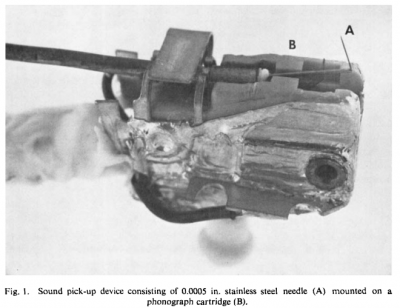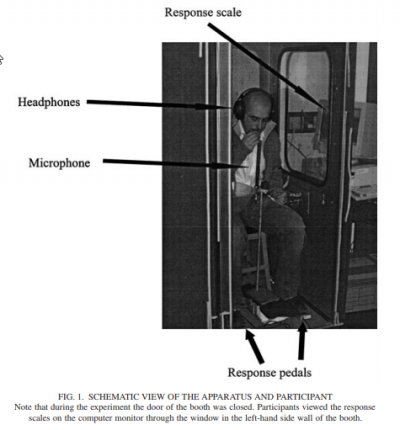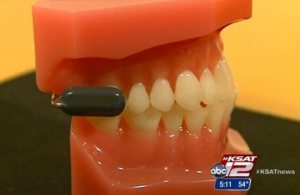This is an old revision of the document!
“Bone conduction is not a new discovery.
Ludwig Van Beethoven overcame deafness by biting a metal rod attached to his piano to hear his work.” source
can we use bone conduction to pick up chewing sounds and can we process and categorize them into something
articles
recording technique
A two component system was devised for recording and analyzing chewing sounds conducted through the bone. A specially designed 0.0005 in. thick stainless steel needle mounted on a phonograph cartridge (Figure 1) was found to be most reliable for picking up vibrations from bony surfaces while a subject chewed a standard portion of a test food for 10 strokes. The signal was fed through an amplifier and recorded on a in. magnetic tape in a tape recorder* run at a speed of 3¾ inch per sec. The sounds were also monitored with earphones by the investigator.
frequency spectrographic analysis of bone conducted chewing sounds in persons with natural and artificial dentitions
The experiments were conducted in a sound-proofed recording studio. Bone Conduction was recorded with a microphone Shadow 4001 (frequency band: 80-15000 Hz) pressed firmly against the cheek of the subject, near the maxillar angle, on the eating side. Air-conduction was recorded with a microphone AKG C414EB (frequency band: 20-20,000 Hz) held on the other side of the subject’s head. The diaphragm of the microphone was in front of the ear canal opening at 8 cm. “contribution of air-and bone-conduction to the creation of sounds perceived during sensory evaluation of foods”
Participants were seated comfortably in a small sound-attenuated booth […] A microphone (Sennheiser ME66/K6 supercardioid, Wedemark, Germany), powered by a Spirit Folio Notepad mixer, was placed such that when participants were seated in the booth, the microphone was positioned directly in front of their mouths. The output from the mixer was then fed through one of three attenuators (Advance Instruments step-attenuator, model A64A, Bethel Park, PA) situated outside the booth, and subsequently through one of three 1/3 octave graphic equalizers (Phonic, model PEQ3300, Tampa, FL) before being fed back to the participant in the booth, via a pair of headphones (Ross RCB200) powered by the output from the mixer. The amplification level was set so that the loudest sounds were presented to the participants at approximately 75 dB(A), which corresponds to a “comfortable” listening level.
Food sounds normally consist of both air- and bone-conducted components, with the relative contribution of the former being greater when the mouth is open rather than closed (Lee et al. 1990; Dacremont et al. 1991).
Given that the only sounds that were modified in the present study were those picked up by the microphone situated outside the mouth, all of the effects reported here should be attributed to the modification of the airborne component of the biting sound (Lee et al. 1990). Nevertheless, it is worth noting that previous research has shown that air-conducted sounds are actually more important than bone conducted sounds for the determination of the crispness of foods (Dacremont 1995).
“the role of auditory cues in modulating the perceived crispness and staleness of potato chips”
hardware
currently a homebrew pickup\piezo pickup microphone seems the best bet.
AliExpress sellers of bone conduction headphones/microphnes bluetooth headsets


